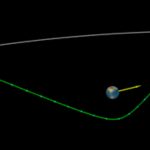
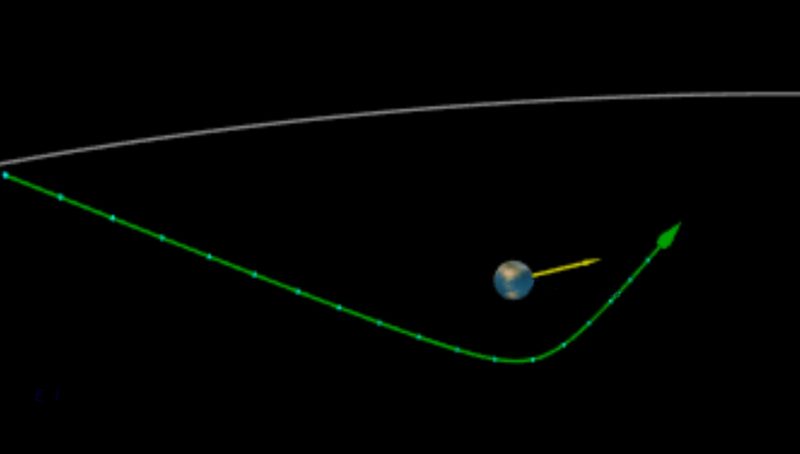
Asteroid 2020 SW will pass so close to Earth that our planet’s gravity will bend the space rock’s trajectory. The green line indicates the asteroid’s trajectory, while the yellow line points to the sun. Illustration by the Minor Planet Center, with modifications by Eddie Irizarry.
A small asteroid discovered on September 18, 2020, from Mt. Lemmon Observatory in Arizona will pass a lot closer than the moon’s distance this week, passing even closer than geostationary satellites. At closest approach, asteroid 2020 SW should pass at an estimated distance of 17,556 miles (28,254 km) from Earth, which is just 0.0735 lunar distances. For comparison, television and meteorological satellites orbit at some 22,300 miles (35,888 km) from our planet’s surface. This approach is so close, and the asteroid is so small, that Earth’s gravity will bend the space rock’s trajectory, as shown in the illustration above.
Closest approach to our planet should occur on September 24 at around 11:18 UTC (7:18 am ET; translate UTC to your time).
Although there’s still some uncertainty in the space rock’s orbit, calculations indicate there is no risk of impact. As a result of the asteroid’s orbit’s uncertainty, closest approach might occur up to six hours earlier or later than expected.
Asteroid 2020 SW is estimated to be about 14 to 32 feet (4.3 to 9.7 meters) in diameter. It’ll brighten as it draws near, but won’t ever get bright enough to see with the eye alone. Look below for charts for telescope users.
Preliminary calculations indicate that asteroid 2020 SW orbits the sun every 372 days. Its orbit is just seven days longer than Earth’s. However – despite the similarities in the orbit of this asteroid and Earth’s orbit – calculations indicate the small asteroid will not impact Earth, at least not for the next approximately 50 years for which its orbit has been calculated.
The space rock is travelling through space at a speed of 17,336 miles per hour (27,900 km/h) or 7.75 km/s relative to Earth.
Asteroid 2020 SW will pass at a safe distance, probably over Australia or New Zealand during its closest approach, as shown here:
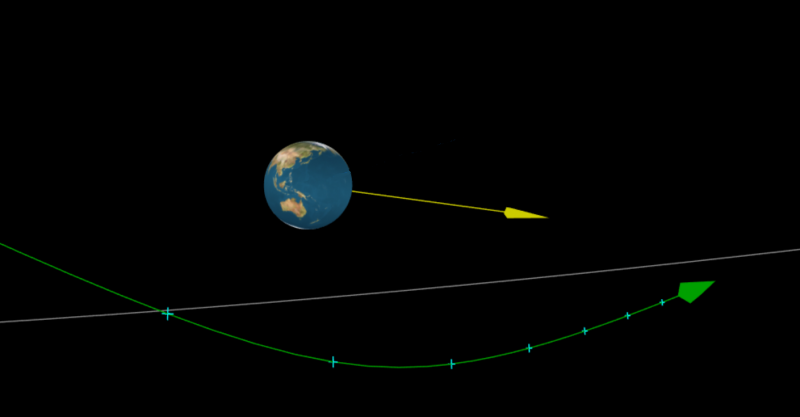
Asteroid 2020 SW will pass at a safe distance, probably over Australia or New Zealand, during its closest approach. Green line indicates the asteroid’s trajectory, with blue marks indicating position every 30 minutes. Yellow line points to the sun. Illustration by the Minor Planet Center, with modifications by Eddie Irizarry.
Will it be visible?
Asteroid 2020 SW might reach a visual magnitude of 13.0 to 13.5, too faint to the unaided eye, but within the reach of observers using a 6- or 8-inch diameter telescope – that is, a very small telescope – and also larger telescopes. The space rock is currently in the constellation of Pegasus the Flying Horse, and will then move to the constellation of Pisces the Fish.
The asteroid might still have a magnitude close to 15 on the night of Wednesday, September 23, but will gradually increase its brightness as it approaches, reaching a magnitude of around 13 to 13.5 during the first hours of Thursday, September 24, and at its brightest just before dawn.
Observers using a telescope might detect the asteroid, which will look like a “star” moving very slowly because of the distance. If you are pointing the telescope at the correct position and time, carefully observe the stars’ pattern and compare it just five minutes later. If you are able to see a “star” that changed position, then it’s not a star, you have found the asteroid!
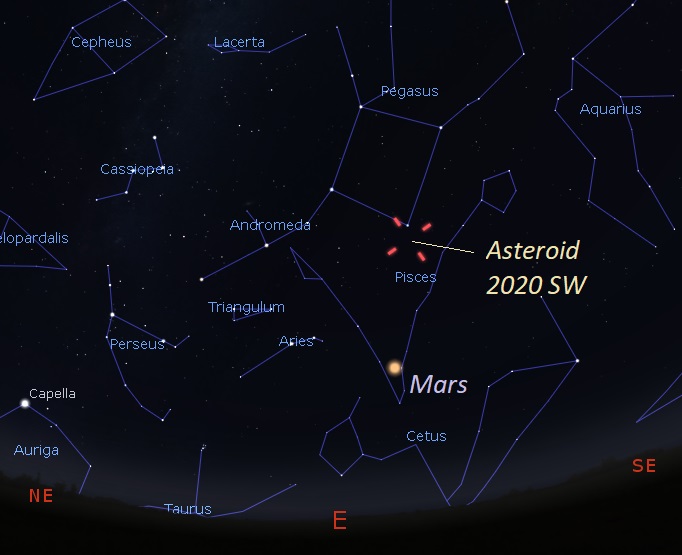
Location of Asteroid 2020 SW on the night of Wednesday, September 23, at around 10:30 p.m. CDT (03:30 UTC on September 24). Facing east, as seen from U.S. The space rock will be located not too far from where we see the star Algenib (Gamma Pegasi), in the Great Square of Pegasus. Illustration by Eddie Irizarry using Stellarium.
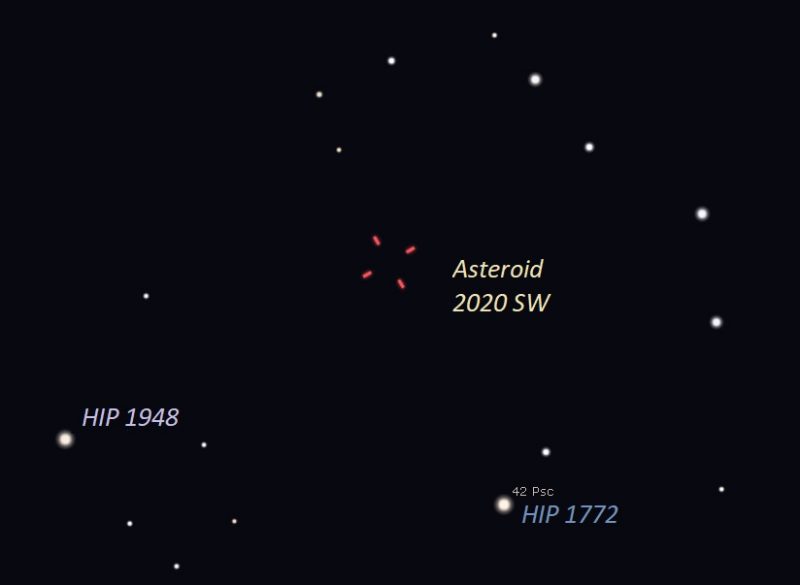
Have a computerized or “GoTo” telescope? Point it to one of the stars shown here (HIP 1948 or HIP 1772) on the night of Wednesday, September 23, 2020, and you might be able to detect asteroid 2020 SW. If the object you’ve pinpointed is in fact the asteroid, you should be able to detect its motion after about 5 to 10 minutes. Illustration by Eddie Irizarry using Stellarium.
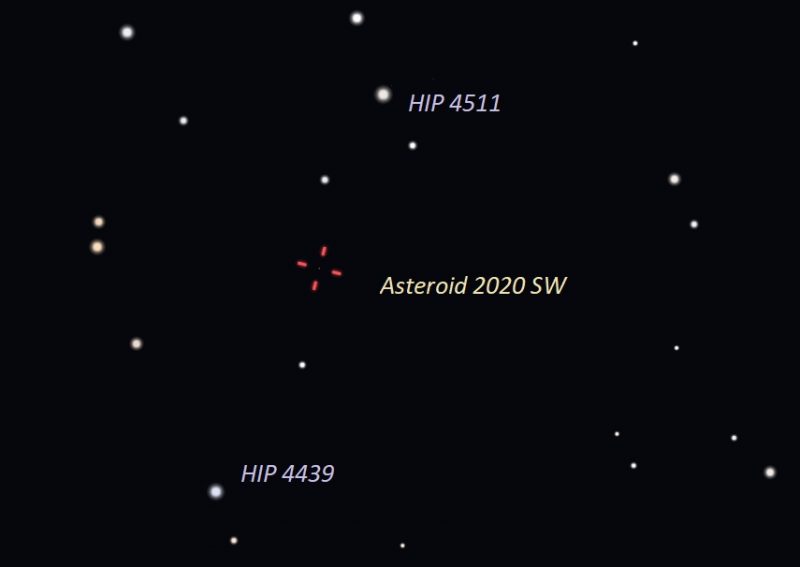
Want to try to spot asteroid 2020 SW very close to the time of its closest approach? Point your computerized or Go To telescope to one of these stars around 4:45 a.m. CDT (5:45 EDT, 09:45 UTC) on Thursday, September 24, 2020. The space rock’s apparent motion should be easier to detect just before dawn on September 24. Illustration by Eddie Irizarry using Stellarium.
Bottom line: Asteroid 2020 SW is small, and it’ll pass exceedingly close to us, so close that Earth will bend its trajectory. It’ll be closest on September 24, 2020 at around 11:18 UTC (7:18 am ET; translate UTC to your time). Its estimated closest distance will be 17,556 miles or 28,254 km from Earth, which is just 0.0735 lunar distances, closer than geostationary satellites. There is no chance it will hit Earth.
from EarthSky https://ift.tt/2EoxaaY


Asteroid 2020 SW will pass so close to Earth that our planet’s gravity will bend the space rock’s trajectory. The green line indicates the asteroid’s trajectory, while the yellow line points to the sun. Illustration by the Minor Planet Center, with modifications by Eddie Irizarry.
A small asteroid discovered on September 18, 2020, from Mt. Lemmon Observatory in Arizona will pass a lot closer than the moon’s distance this week, passing even closer than geostationary satellites. At closest approach, asteroid 2020 SW should pass at an estimated distance of 17,556 miles (28,254 km) from Earth, which is just 0.0735 lunar distances. For comparison, television and meteorological satellites orbit at some 22,300 miles (35,888 km) from our planet’s surface. This approach is so close, and the asteroid is so small, that Earth’s gravity will bend the space rock’s trajectory, as shown in the illustration above.
Closest approach to our planet should occur on September 24 at around 11:18 UTC (7:18 am ET; translate UTC to your time).
Although there’s still some uncertainty in the space rock’s orbit, calculations indicate there is no risk of impact. As a result of the asteroid’s orbit’s uncertainty, closest approach might occur up to six hours earlier or later than expected.
Asteroid 2020 SW is estimated to be about 14 to 32 feet (4.3 to 9.7 meters) in diameter. It’ll brighten as it draws near, but won’t ever get bright enough to see with the eye alone. Look below for charts for telescope users.
Preliminary calculations indicate that asteroid 2020 SW orbits the sun every 372 days. Its orbit is just seven days longer than Earth’s. However – despite the similarities in the orbit of this asteroid and Earth’s orbit – calculations indicate the small asteroid will not impact Earth, at least not for the next approximately 50 years for which its orbit has been calculated.
The space rock is travelling through space at a speed of 17,336 miles per hour (27,900 km/h) or 7.75 km/s relative to Earth.
Asteroid 2020 SW will pass at a safe distance, probably over Australia or New Zealand during its closest approach, as shown here:

Asteroid 2020 SW will pass at a safe distance, probably over Australia or New Zealand, during its closest approach. Green line indicates the asteroid’s trajectory, with blue marks indicating position every 30 minutes. Yellow line points to the sun. Illustration by the Minor Planet Center, with modifications by Eddie Irizarry.
Will it be visible?
Asteroid 2020 SW might reach a visual magnitude of 13.0 to 13.5, too faint to the unaided eye, but within the reach of observers using a 6- or 8-inch diameter telescope – that is, a very small telescope – and also larger telescopes. The space rock is currently in the constellation of Pegasus the Flying Horse, and will then move to the constellation of Pisces the Fish.
The asteroid might still have a magnitude close to 15 on the night of Wednesday, September 23, but will gradually increase its brightness as it approaches, reaching a magnitude of around 13 to 13.5 during the first hours of Thursday, September 24, and at its brightest just before dawn.
Observers using a telescope might detect the asteroid, which will look like a “star” moving very slowly because of the distance. If you are pointing the telescope at the correct position and time, carefully observe the stars’ pattern and compare it just five minutes later. If you are able to see a “star” that changed position, then it’s not a star, you have found the asteroid!

Location of Asteroid 2020 SW on the night of Wednesday, September 23, at around 10:30 p.m. CDT (03:30 UTC on September 24). Facing east, as seen from U.S. The space rock will be located not too far from where we see the star Algenib (Gamma Pegasi), in the Great Square of Pegasus. Illustration by Eddie Irizarry using Stellarium.

Have a computerized or “GoTo” telescope? Point it to one of the stars shown here (HIP 1948 or HIP 1772) on the night of Wednesday, September 23, 2020, and you might be able to detect asteroid 2020 SW. If the object you’ve pinpointed is in fact the asteroid, you should be able to detect its motion after about 5 to 10 minutes. Illustration by Eddie Irizarry using Stellarium.

Want to try to spot asteroid 2020 SW very close to the time of its closest approach? Point your computerized or Go To telescope to one of these stars around 4:45 a.m. CDT (5:45 EDT, 09:45 UTC) on Thursday, September 24, 2020. The space rock’s apparent motion should be easier to detect just before dawn on September 24. Illustration by Eddie Irizarry using Stellarium.
Bottom line: Asteroid 2020 SW is small, and it’ll pass exceedingly close to us, so close that Earth will bend its trajectory. It’ll be closest on September 24, 2020 at around 11:18 UTC (7:18 am ET; translate UTC to your time). Its estimated closest distance will be 17,556 miles or 28,254 km from Earth, which is just 0.0735 lunar distances, closer than geostationary satellites. There is no chance it will hit Earth.
from EarthSky https://ift.tt/2EoxaaY

Aucun commentaire:
Enregistrer un commentaire